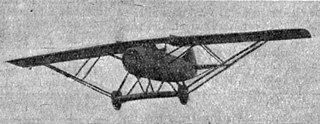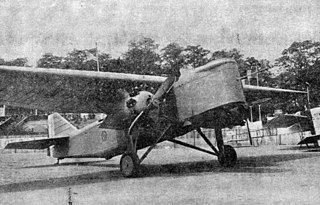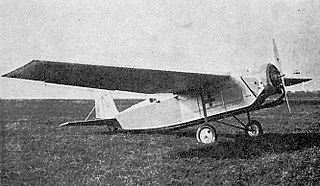
The Kellner-Béchereau E.1 was an experimental single engine, single seat light aircraft, designed in France in the 1930s. It was a monoplane with a novel "double" wing, the rear part providing lift and lateral control as well as acting as slotted flaps.

The Kellner-Béchereau EC.4 and Kellner-Béchereau ED.5 were a pair of French training aircraft with side-by-side seating and a novel "double wing" patented by their designer, Louis Béchereau. The principal difference was that the EC.4 had an all-wood structure whereas the ED.5 was all-metal. Both were single-engine, mid-wing cantilever monoplanes.

The Potez 37 was a two-seat, long range reconnaissance aircraft built to compete for a French government contract. It flew in mid-1930 but did not win the competition, so only two were completed.

The Potez 40 was a French three-engine, braced high-wing monoplane designed and built in response to a French government programme for colonial transport and policing aircraft duties.
The Caudron C.220 was a two-seat French biplane trainer. Only two were built, using different engines.

The Delanne 11 was a French two seat touring aircraft. Only one was built.

The Salmson-Béchereau SB-5 was a two-seat fighter aircraft built for a French government programme in 1925. Despite a powerful engine it did not perform well and only one was built.

The Dewoitine D.480 was a French single engine side-by-side sports and training aircraft built in the early 1930s. Two were completed and flew with several different radial engines. One remained active through the 1950s.

The Kellner-Béchereau 28VD was a French racing aircraft built to compete in the 1933 Coupe Deutsch de la Meurthe. Engine failure and damage sustained in the consequent emergency landing prevented the 28VD from participation in the race.

The Nieuport-Delage NiD 740 was a French trimotor monoplane designed to carry night mail. Two were built in 1930.

The Wibault 220 or Wibault R.N.3 220 was a twin-engined French night reconnaissance aircraft. Two were built in 1930 to a government contract.

The Guillemin JG.40 was designed and built to meet a French government requirement for a small air ambulance capable of operating in the colonies. Two were completed and performed well but the JG.40 did not reach production.
The Potez 42 was designed and built in 1930 to meet a French government requirement for a small air ambulance capable of operating in the colonies. It did not reach production.

The Guillemin JG.10 or Blériot-Guillemin JG.10 was a French two seat touring aircraft, designed to be as simple and safe to fly and maintain as a car, with similar facilities, as well as provision for parachutes.

The Couzinet 20 was a low power, three-engined aircraft designed in France in 1929 for postal duties, though it could have been configured to carry three passengers or as a medical transport. Variants flew with three different engines but only two airframes were completed.
The Couzinet 100 was a three-engined, three-seat touring aircraft designed and built in France in 1930. Two variants, the Couzinet 101 and Couzinet 103, were very similar apart from their engines; no variant reached production.
|} The Poite 3 was a one-off, all metal touring aircraft which seated two in tandem. It was built and flown in France in 1931.

The Hanriot H.25 was a French, single-engined, six passenger airliner built in 1926. Only one was flown.
The Muniz M-5 was the first of Antonio Guedez Muniz's aircraft designs to fly; soon afterwards he became the first Brazilian to design an aircraft which reached series production. The sole example of the M-5, built while he was a student in France by Caudron, was a low wing cabin tourer or military liaison aircraft.

The Albert A-10 was a four-seat French transport aircraft which could be rapidly converted into an air ambulance. Two or three examples were built between 1929 and 1932, using at least two different engines, but neither variant reached production.



























